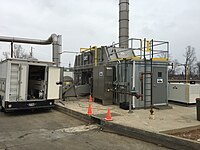
Photo from wikipedia
Abstract Composite manufacturing processes adapted for assisted-additive manufacturing (AM) have recently been proposed. Extrusion-based AM utilizes shear-driven alignment in producing printed structures where polymers and fibers naturally align parallel to… Click to show full abstract
Abstract Composite manufacturing processes adapted for assisted-additive manufacturing (AM) have recently been proposed. Extrusion-based AM utilizes shear-driven alignment in producing printed structures where polymers and fibers naturally align parallel to the material flow. Convergent flow geometries become the dominant processing route for thermoplastic-melts and thermoset polymer extrusions. For rotational fibers, the phenomenon known as Jeffrey orbits poses issues during extrusion through a convergent channel, resulting in a randomized fiber architecture. Methods of minimizing Jeffrey orbits include the application of an additional external force such as a magnetic field to arrest or counteract the rotation. This work explores a combination of magnetic forces in conjunction with adjusted channel geometries using theory and experimental observations. The findings suggest the ability to alter fiber orientation in flow in a 300 cP viscosity matrix by modifying the extrusion channel geometry.
Journal Title: Additive manufacturing
Year Published: 2020
Link to full text (if available)
Share on Social Media: Sign Up to like & get
recommendations!